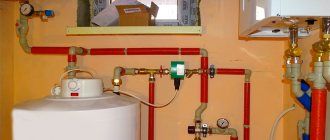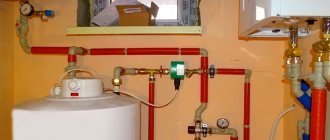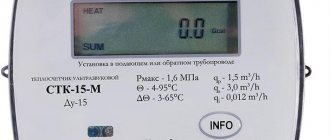Photo source: https://www.pexels.com/
Perhaps one of the most difficult to understand in the Rules for the Provision of Utility Services is paragraph 54, which regulates the procedure for determining the cost of hot water supply (DHW) and heating services if there is no centralized heating supply and DHW in the apartment building. This paragraph is written so “clumsily” that many simply cannot understand its “intricacies”. In this article we will tell you how you can determine the cost of hot water supply and heating in a situation where hot water supply and heating are produced using equipment that is part of the common property of an apartment building.
Let's start by studying clause 54 of the Rules for the provision of utility services to owners and users of premises in apartment buildings and residential buildings, approved by Decree of the Government of the Russian Federation of May 6, 2011 No. 354 (hereinafter referred to as the Rules).
The first paragraph of clause 54 of the Rules states that in the event that the contractor independently produces utility services for heating and (or) hot water supply using equipment that is part of the common property of the apartment building, the cost of the utility service for heating and (or) hot water supply is calculated based on the volume, communal resource consumed in the production of the above public services.
Taking into account the fact that, according to clause 37 of the Rules, the billing period is a month, then to calculate the cost of heating and hot water services it is necessary to take the volumes of utility resources consumed during the month
.
Let's look at how the cost of hot water is determined when preparing it yourself.
According to paragraph 5 of clause 54 of the Rules, the amount of consumer payment for utility services for hot water supply (in the absence of centralized hot water supply) is determined in accordance with formulas 20 and 20(1) of Appendix No. 2 to the Rules as the sum of 2 components:
- the product
of the volume
of hot water
consumed by the consumer , prepared by the contractor,
and the tariff for cold water
; - work volume (quantity) of a communal resource
, used
to heat cold water
for the purpose of providing a hot water utility service,
and the tariff for the utility resource
.
It seems that everything is logical, if there is hot water in the house, it means it came from somewhere. Accordingly, hot water includes the cost of cold water and the cost of heating it to the required temperature, which, in our case, consists of the cost of thermal energy.
And now the most interesting part begins, namely the calculation of the cost of one cubic meter of hot water.
We open formula 20 of Appendix No. 2 to the Rules and see the following:
This formula can be divided into 2 parts:
First part
– cost of cold water included in hot water. Here, as a rule, no questions arise, since the volume of service consumed in a particular premises is known, and the tariff for cold water is set at the level of the constituent entity of the Russian Federation.
Second part
– the cost of utility resources necessary to heat a cubic meter of cold water to the temperature required to provide hot water supply.
Let's look at this part of formula 20 in more detail, namely the indicator - specific consumption for heating water (hereinafter referred to as specific consumption).
This specific consumption in the Rules is described as “ the specific consumption of the v-th utility resource for water heating, approved in accordance with the legislation of the Russian Federation by the authorized body, the standard consumption of the v-th utility resource for water heating
for the purpose of providing public hot water services
.” Many, having read this formulation, believe that the specific consumption indicator is always equal to the standard for heating cold water
. However, it is not.
The Rules separately describe the procedure for determining the amount of specific consumption in a situation where an apartment building is equipped with a collective (common house) metering device
a communal resource that is used to heat hot water for domestic hot water purposes and provide utility heating services.
In such a situation, the specific consumption is determined by formula 20.1 of the Rules: Let's break this formula down into “parts”.
In the numerator we see indicator V, which in the Rules is designated as “ the volume of communal resources used during the billing period for the production of thermal energy for the purpose of providing communal services for heating and for heating water for the purpose of providing public services for hot water supply, consumed in residential and non-residential premises and for general house needs of an apartment building
».
In a situation where heating and hot water services in an apartment building are provided using equipment included in the common property, the management organization (HOA) in the numerator of formula 20.1 indicates the volume of communal resources that was spent on heating cold water and heating according to the readings of the common building meter.
Everything seems logical, but hot water can be heated
:
- using thermal energy obtained from the heating network;
- using electrical energy;
- using gas.
Depending on the utility resource used, the numerator may display Gcal, kW/hours or cubic meters.
In our case, we will consider heating water using thermal energy received in the MKD from the RSO.
The numerator is clear, we take the denominator, which consists of the sum of the indicators
Q gv and Q o,
which are defined as
“ the amount
of thermal energy produced for the purpose of providing communal services for heating and for heating water for the purpose of providing public services for hot water supply, consumed in residential and non-residential premises and for general house needs of an apartment building, determined in accordance with paragraph 54 of the Rules
";
We open clause 54 of Rules No. 354 and see that:
The total volume (quantity) of heat produced by the contractor during the billing period
energy used for the provision of public heating services and (or) for the provision of public hot water services is determined by:
- according to meter readings, installed on the equipment
, with the use of which the contractor provided utility services for heating and (or) hot water supply;
- in the absence of the above metering devices
- as
the sum of volumes (quantities)
of thermal energy used for the purpose of providing communal services for heating and (or) for the purpose of providing public services for hot water supply, determined by:
— readings of individual and general (apartment) heat energy meters
, with which residential and non-residential premises of consumers are equipped;
— volumes (quantities) of thermal energy consumption
, used for the purpose of providing communal services for heating and (or) providing communal services for
hot water supply
, determined in the manner established by these Rules for consumers whose residential and non-residential premises
are not equipped with such metering devices
;
— volumes (quantities) of thermal energy consumption used to provide public services for hot water supply for general house needs
, determined on the basis
of standards for hot water consumption for the purpose of maintaining common property in an apartment building and standards for the consumption of thermal energy used to heat water for the purpose of hot water supply
.
note
that DHW metering devices do not determine the volume of thermal energy that was spent on heating cold water to the required temperature, but only determine the volume of hot water consumed.
Therefore, to determine the volume of thermal energy produced for the needs of hot water supply and heating, it is necessary to sum up
:
- the volume of thermal energy consumed in the premises that equipped
IPU for heating;
- the volume of thermal energy consumed in the premises that not equipped
IPU for heating, calculated based on the standard for thermal energy consumption for heating needs (taking into account paragraph 4 of clause 42.1 of the Rules, taking into account the legal position of the Constitutional Court of the Russian Federation. Read more about this here;
- the amount of thermal energy used to heat cold water for hot water supply. As we said above, IPU for DHW do not determine the volume of thermal energy, which means that the volume of thermal energy for DHW purposes is determined by “ in the manner established by these Rules for consumers whose residential and non-residential premises are not equipped with such metering devices
", namely
as the product of the volume of consumed service by the value of the standard for heating cold water
(according to formula 23 of Appendix No. 2 to the Rules); - the volume of thermal energy used for the purpose of supplying hot water supply to the KRSOI, determined by multiplying the standard for DHW consumption at the KRSOI by the area of the premises included in the common property.
As a result of applying all the above-described “unknowns” in the denominator of formula 20.1 of Rule No. 354 in the months when the heating service is provided
the amount of “
thermal energy produced
” will be obtained, which will not coincide with the volume of the communal resource “
used during the billing period for the production of thermal energy
.”
As can be seen from the figure below, formula 20.1 of Rule No. 354 actually introduces a certain “correction factor” to the heating standard
.
Factors influencing the formation of value for the population
The price of hot water at a one-component tariff is influenced by the following factors:
expenses for water supply, including laying and repairing pipes, purchasing necessary equipment;- purchase of reagents for liquid purification;
- heating costs;
- costs for laboratory testing of water quality;
- payment of salaries to service personnel;
- enterprise profit.
Since 2013, a two-component tariff began to be introduced.
The price of hot water is considered here as a component. It is formed from the tariff for cold water and the cost of energy spent on heating it. With a two-component tariff, the cost of hot water, in addition to the factors listed above, is influenced by 3 more circumstances:
- availability of heated towel rails;
- degree of thermal insulation of pipes;
- an open or closed water supply system is used.
The amount of payment for DHW depends on the availability of a meter. Different calculation schemes are used.
How is the tariff determined?
The formation of payment for heating cold water occurs according to the following criteria:
The standards approved by local authorities are taken into account.- Also included in the formation of the tariff are the costs incurred by the city water utility for servicing the heating networks adjacent to the house and the boiler room.
- The volume of thermal energy lost when water passes through pipes is taken into account.
- Additionally, the cost of supplying water to the residents of the house is taken into account.
- Amount of water consumed per month.
- The amount of energy that was spent heating cold water in the boiler.
- Cold water heating coefficient.
We can conclude that heating is not a separate utility service for which you need to pay, but a component of hot water supply.
What determines the heating coefficient of cold water in a boiler:
- Temperature. Throughout the year, the temperature of the water supplied to the boiler varies; it is set in accordance with SanPiN standards.
- The total amount of water consumed by the residents of the entire house. This indicator depends on how many apartments are in the apartment building.
We recommend an article on the topic
What is cold water for domestic hot water and how is payment for this service calculated?
Calculations by meter and by standards - what is the difference?
When using IPU, the difference between the current and previous meter readings is paid. You only need to pay for the volume of water used. The calculation is made using a one- or two-component system.
In the absence of IPU, the calculation is made based on the consumption rate per person. For each resident, a certain amount of hot water consumption per month is established, subject to payment.
A similar method is used in the following cases:
- there is no meter in the house;
- The IPU was submitted for verification more than 3 months ago;
- the service company has not received information on the meter for more than 3 months.
The calculation is made based on the number of registered residents in the apartment. The rate of hot water per person is multiplied by the number of registered residents, and the final volume is obtained, payable at a one- or two-component tariff.
If the apartment does not have an IPU, then an increasing factor of 1.5 is applied. The cubic meters calculated according to the standards are multiplied by 1.5, and the resulting volume is paid for.
If a meter is installed in the apartment, then all calculations are carried out according to its readings. If there is no IPU, then payment does not depend on the amount of water used.
The final amount is obtained by multiplying the consumption standard established in the region by the number of registered residents and by the increasing factor.
Prices for 1 cubic meter with and without IPU
Tariffs for hot water with a meter differ in different regions of Russia and range from 100 to 200 rubles per 1 cubic meter. If the meter is not installed, then the amount of payment for 1 person will be from 500 to 1500 rubles.
Current tariffs, as well as data for independent calculations in the absence of a meter for large cities with a population of over a million, can be found on the official websites of various government agencies.
For example:
- Moscow.
- Saint Petersburg.
- Novosibirsk
- Samara.
Utility tariffs
A tariff is the price for a service, which can be set either per unit of resource provided (for example, per cubic meter of water) or per unit of time for those services that are provided to everyone equally (for example, elevator maintenance).
Federal legislation establishes that tariffs can be changed and new ones introduced no more often than once a year. Regional standards for tariffs are established annually by the Government of the Russian Federation, however, exact tariffs are introduced at the local level, taking into account the specifics - for this purpose, an examination of the costs of providing consumers with services and their validity is carried out.
As for costs, their structure for utilities and housing services differs significantly: utilities are characterized by a high share of the resources acquired to provide them, and housing is characterized by the necessary labor force.
For example, when calculating the cost of heat supply, the cost of purchasing fuel is about 35-40%, and another 10% is spent on electricity, which is also required for the operation of the systems. When paying for water supply, about 20-25% is spent on purchasing water, and the same amount on electricity.
In the structure of expenses for housing services, the wages of workers involved in their provision are about 50-60%, another 10-15% is spent on necessary materials and 8-10% on electricity. The costs of materials are higher in the cost structure of a service such as repairs. It is the different composition of costs that explains why tariffs for different types of housing and communal services can vary greatly.
Utilities must be paid monthly, before the tenth day, in full - if there is a delay, a penalty may be charged, and if there is prolonged non-payment, the right to use housing and communal services will be deprived, while the debt for services already provided will still remain.
Examples of DHW cost calculations
Using a two-component system makes it difficult to calculate the cost of the service. Below are examples of calculations with or without meters for both types of tariffs.
If there is an IPU
If the calculation is carried out according to a one-component tariff, then the formula is used:
P =VxT, where:
- V is the volume of hot water used in m3,
- T—cost of 1 m3 of hot water in rubles/m3.
If, for example, there is a difference of 5 m3 between the previous meter reading and the current one, and the cost of 1 m3 is 180 rubles, then the amount to be paid is P = 5 x 180 = 900 rubles.
In the case of two components in the system, the cost is calculated using the formula:
Pdv= V x Txv + Q x Tt/e, where:
- V—volume of hot water used in m3,
- Тхв — price of 1 m3 of cold water in rubles/m3,
- Q is the amount of energy spent on heating water of volume V in Gcal,
- Ht/e - cost of 1 Gcal in rubles/Gcal.
Let 5 m3 of water be spent, the price for 1 m3 of cold water supply Txw = 28 rubles. Then the first part of the formula V x Тхв = 5 x 28 = 140 rubles. To find the second part, you need to determine Q.
To heat 1 m3 of water to 60-75°C you need to spend approximately 0.062 Gcal. This value must be multiplied by the volume of used hot water and get Q = 0.062 x 5 = 0.31 Gcal.
The resulting amount of energy must be multiplied by Tt/e. The price of 1 Gcal differs in different regions of Russia. Let it be equal to 2600 rubles. for 1 Gcal, then QxTt/e = 0.31 x 2600 =806 rub. Total, price for a two-component tariff Pdv = 140 + 806 = 946 rubles.
How to calculate how much it will cost without IPU
For a one-component system, use the following formula:
KxSxV1xT, where:
- K - increasing factor equal to 1.5,
- S is the number of registered residents,
- V1— norm of water volume per person per month in m3,
- T - cost of 1 m3 of hot water in rubles/m3.
Let there be 2 people registered in the apartment, the norm for 1 is 4.5 m3, T = 180 rubles. Then P = 1.5 x 2x 4.5 x180 = 2430 rub. If a multiplying factor is not applied, then there is no need to multiply by 1.5.
The two-component tariff can be calculated using the formula:
Pdv= K x S x V1 x Txv + Q x Tt/e, where:
- K = 1.5,
- S = 2 residents,
- V1 = 4.5 m3,
- Tхв = 28 rub.,
- Q=0.062xSx
- V1 = 0.062 x 2 x 4.5 = 0.558 Gcal.
Total Pdv = 1.5 x 2 x 4.5 x 28 + 0.558 x 2600 = 1828.8 rub.
Also, if K is not used, then there is no need to multiply by 1.5.
What is it and what does it look like on the receipt?
DHW (Heating) refers to the total cost of energy spent heating cold water. Hot water in apartment buildings is paid for by residents according to the meter or individual coefficient .
Additionally, the tariff per cubic meter is taken into account, which is set according to the standards of the region where the citizen lives. To find the hot water supply item in the receipt for payment of housing and communal services, you need to look at the “Type of payment” column. In the subsection “Maintenance of common property” there will be a line “DHW. Heating”, which provides information on the tariff, energy consumption rate, SOI coefficient and SME.
Technological process:
- Cold water is supplied to an apartment building.
- With the help of a boiler, heating occurs to the set temperature.
- The water is then supplied to the residents of the house.
Benefits for utilities
There are a number of citizens who, by law, have the right to receive benefits on utility bills, that is, to pay a certain percentage less. Let's look at who has this right and how it is formalized.
Who is eligible
All categories of citizens receiving the right to benefits and compensation are regulated in detail in regional legislation, so this issue needs to be clarified at the local level. However, there are main categories that can count on benefits in almost any region. These include:
- Pensioners - if utility costs exceed 20% of total income (in some regions this threshold may be lower), a citizen is entitled to benefits for utility bills. For the majority of pensioners, this norm is met.
- Disabled people can also count on state assistance, as a result of which they will need to pay half of the calculated amount.
- Veterans are entitled to a 50% discount on housing and communal services costs, and certain categories are completely exempt from payment.
- Large families - if a family has three children or more, then it can count on a 30% discount on the amount that it must pay for housing and communal services, but only within the limits of consumption standards. If there are 10 or more minor children in the family, the discount increases to 50%.
- Single mothers - the exact amount of the benefit in this case varies depending on the region.
In addition to the listed categories, benefits are provided to many other, narrower ones, for example, citizens resettled from areas of radioactive contamination, families with disabled children, orphans, and so on.
Receipt procedure
To apply for benefits, you need to apply to the multifunctional center (MFC) or the social protection department at your place of residence.
Registration will vary depending on which beneficiaries the citizen belongs to - federal or regional. In the first case, registration is carried out once, in the second you will need to do this every six months.
To receive benefits you need the following documents:
- passport;
- a certificate confirming the status of a beneficiary;
- an extract from the house register or a certificate of registration;
- confirmation of ownership of housing;
- receipts to confirm the absence of arrears in payment of utility services - and if there are any, benefits will not be issued.
Using the calculator
In order not to carry out all these long calculations yourself, you can simply use a special housing and communal services calculator, which already contains all the formulas we have considered, and you only need to enter your parameters - your current tariffs and meter readings.
Such a calculator for housing and communal services can be found, for example, on the website of the Federal Antimonopoly Service. Here you don’t even have to find out the tariffs yourself - just enter your place of residence, and the cost of all housing and communal services will be calculated.









